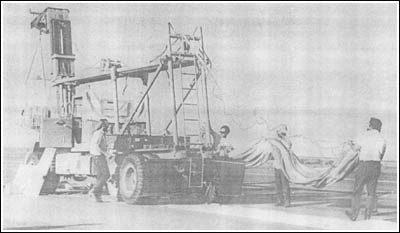The Material Area Rio Cuarto, is a military installation original conceived in 1944 as the Taller Regional Rio Cuarto (Regional Workshop Rio Cuarto). It is placed on a terrain of 900 hectares in the town of Las Higueras, located on the outskirts of the city of Rio Cuarto, a major city of the southern part of the Cordoba province.
It's official opening took place on July 19, 1946 beginning its work immediately with Curtiss Hawk and Glenn Martin aircraft inspections. By 1948, also Beechcraft AT-11 and Northrop 8A2 planes were added and a year later arrived there the first jets: the Gloster Meteor.
In 1952, the activity was intense which lead to expand the infrastructure and buildings of the base. In subsequent years the inspection and maintenance task included too the Avro Lancaster and Avro Lincoln heavy bombers, the F-86 Sabre jet, Morane Saulnier 760 Paris and since the 70's the Canberra bombers.
It was at that time -in the 70's- when was studied the possibility of setting up a permanent flight center to launch stratospheric balloons.
Activities with balloons

Argentine had several isolated initiatives in the field of scientific ballooning before starting a national program on its own. First, in the early 60's scientists used neoprene balloons fitted with special valves to prolong their flight. These experiences were carried out by researchers from the Institute of Cosmic Radiation (nowadays the Institute of Astronomy and Space Physics - IAFE). A few years later, NASA's Goddard Space center, with participation of the National University of Tucuman, and support from the Air Force conducted two balloon launches from Tucuman. However, the initial kick of the national balloon program took place in November 1969 with the launch from the Second Air Brigade, a military facility located in Parana, Entre Rios of the first large balloon, carrying an X-radiation experiment developed by the Rice University from United States. The operation, conducted by the National Center for Atmospheric Research (NCAR) in cooperation with the National Commission on Space Research (CNIE), was the foundation of the "Galaxia" program, generic term to refer to each of the campaigns undertaken in Argentine from that moment on. The cooperative campaigns with NCAR would be performed in Paraná until 1973.
Since 1974, in response to the research requirements from CNIE the balloon launches were transferred to Rio Cuarto, establishing the so-called Balloon Launch Center inside the Area Material Rio Cuarto in Las Higueras. This set a very important landmark because for the first time the country had its own ability to launch big balloons without having to depend of NCAR as before. Rio Cuarto was chosen due to its central location thus enabling the development of missions which extended up to 1000 km in east or west direction before reaching the country's border.

Part of the infrastructure available included a 5-ton truck equipped with a hydraulic crane adapted to serve as "launch vehicle" to ensure that the gondola is not dragged on the ground at launch, a communications center, an office for weather reports, a building for the assembly of instruments and payloads, a laboratory of electronics and security and administrative facilities. For each flight were available a GMD radar to accurately determine the impact location of the payload, and a Cessna 182 aircraft to track and recover the instruments flown. The launches were performed from one side of the airstrip of the base.
To inflate the balloons the center counted with 3 trailers, containing 22 tanks of hydrogen of 240 liters capacity each. The first series of launches from Rio Cuarto were made in 1974.
Paradoxically, althought the site was created to be the main launch base of the country, there was not much activity there, with some isolated missions performed until the last ones performed in 1977, the moment on which the activity with balloons started to be more centered in the Mendoza Provincial Airport, near El Challao, in the Andes Mountains.
Turning back to the history of the Area Material Rio IV, the incorporation of Mirage supersonic aircraft to the Argentinian Air Force in the mid-70's give a new thrust to the area, which in 1978 was renamed as Rio Cuarto Military Air Base, which implied not just an administrative and organizational restructuring but required the construction of shelters for these new planes.
Nowadays, Las Higueras also host a civilian airport managed by Aeropuertos Argentina 2000.
Table of balloons launched from Rio Cuarto
| Date | Hour | Flight Duration | Experiment | Payload landing place or cause of the failure |
|---|---|---|---|---|
| 4/1/1974 | 22:07 utc | 16 h | MEASUREMENTS OF LOW ENERGY GAMMA RADIATION | Near Ortiz Basualdo, Buenos Aires, Argentine |
| 4/6/1974 | --- | X-RAY ASTRONOMY | Balloon Failure | |
| 4/6/1974 | 4 h | AERIAL PHOTOGRAPHY | --- No Data --- | |
| 4/4/1976 | 21:10 local | 1 h | ALIR-I (Infrared Telescope) | Balloon failure |
| 4/13/1977 | 21:45 local | 6 h | ALIR-I (Infrared Telescope) | --- No Data --- |
If you consider this website interesting or useful, you can help me to keep it up and running with a small donation to cover the operational costs. Just the equivalent of the price of a cup of coffee helps a lot.

